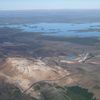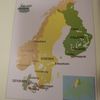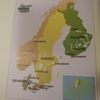23.8.2020 | 01:19
Įtti aš verša fyrsta einkavélin, sem ekki vęri hęgt aš magalenda.
Eftir aš Piper PA-28 kom fram į sjónarsvišiš um 1960 var hśn žaš vel hönnuš hjį hönnušinu Fred Weick, aš enn ķ dag er veriš aš smķša nż afbrigši af henni, svo sem dķsilknśna vél.
Weick afrekaši žaš 1937 aš hanna lįgžekju, sem ekki žurfti fótapedala, žvķ aš hśn var ekki meš hlišarstżri. Ķ Fyrri heimsstyrjöldinni misstu margir flugmmenn fęturna ķ brotlendingum, en žeir gįtu flogiš žessari tveggja manna vél, sem hét Ercoupe.
Hęšarstżri hennar voru žannig hönnuš, aš žį įtti ekki aš vera hęgt aš lįta hana ofrķsa eša fara ķ spuna. Fyrir bragšiš varš aš vera į varšbergi aš fletja flugiš viš lendingu nógu vel śt til aš lenda ekki of harkalega.
Žess mį geta aš eitt afsprengi Cherokee er tveggja hreyfla og hefur talsvert veriš notuš ķ flugkennslu, auk žess sem hśn var löngum einhver hagkvęmasta tveggja hreyfla einkavélin.
Žegar gerš var Cherokee vél meš uppdraganlegum hjólin, var hśn meš bśnaši, sem var žannig hannašur, aš ekki vęri hęgt aš magalenda henni.
Skynjari var nešan į vélinni, sem nam lofthrašann, og fęri hann nišur fyrir įkvešinn hraša, setti vélin sjįlf nišur hjólin žótt flugmašurinn gleymdi žvķ.
En žaš var hér į Ķslandi, sem slķkri vél var samt ķ fyrsta skipti lent į maganum og geršist žaš į Reykjavķkurflugvelli.
Flugmašurinn gleymdi aš setja hjólin nišur en kom of lįgt inn til lendingar vegna žess hvaš hśn var hlašin og gaf fullt afl til žess aš foršast harkalega lendingu.
Hreyfillinn dęldi svo miklu lofti į fullu afli ķ gegnum skynjaran aš hann sżndi mun meiri hraša en hinn raunverulega alveg nišur undir jörš, og žegar flugmašurinn dró af aflinu, var vélin komin svo nįlęgt, aš hjólin komust ekki alla leiš nišur svo aš vélin magalenti.
Žetta var fyrir um hįlfri öld og bśnašurinn var lagšur nišur.
Nś geta flugmenn žvi magalent svona vélum eins og atburšurinn į Ķsafirši sżnir.

|
Sneru viš vegna magalendingar |
| Tilkynna um óvišeigandi tengingu viš frétt | |








Athugasemdir
Flaug 10 sinnum yfir hafiš į milli Skotlands og Ķslands į Turbo Arrow IV (PA-28RT-201T). Į žeim tveimur vélum sem ég flaug hafši žessi skynjari, sem Ómar minnst į, veriš geršur óvirkur. Žaš var yfirleitt gert į slķkum vélum ķ Sviss.
Haukur Kristinsson (IP-tala skrįš) 23.8.2020 kl. 11:26
By Wade Sullivan, Cherokee Pilots of the West Coast
Throughout the 1950s, Piper had great success in the low-end airplane market with its PA-20 Pacer and PA-22 Tri-Pacer. Although old-school tube-and-fabric designs, Piper was able to produce them cheaply, and they performed very well compared to their competition.
As early as 1952, however, the need for a more-modern, all-metal airplane to compete with Cessna’s Model 170 had been acknowledged. It was then that Piper officials tried to purchase a four-place Mooney design (that eventually became the Mooney Mark 20), but designer Al Mooney refused to sell.
After considering other designs available at the time, Piper decided to design its own modern airplane. In 1953, aeronautical engineer Fred Weick (NACA cowling, Ercoupe) did a cost study for Piper to find if building an all-aluminum airplane was economically feasible. Weick determined that Piper was spending 8% more to produce the Tri Pacer than Cessna was spending to produce the 170.
Weick had developed a friendship with Pug Piper, son of company president William Piper. Together, in 1956 and early 1957, Weick and Pug Piper established the overall design of a next-generation Piper airplane. It was to be a low-wing all-metal design, with tricycle landing gear, 150-hp Lycoming engine, and a cabin width of 42 inches, roomier than the Tri Pacer, but not as wide as the more-expensive PA-24 Comanche that was just entering production.
In early 1957, Piper contracted with airplane designer John Thorp (T-18, Sky Scooter) to do a preliminary design study of the PA-28. By April, Weick had joined Piper as the director and chief engineer of the Piper development center and had hired aeronautical engineer Karl Bergey to be the chief developer of the PA-28. Bergey, with input from Weick and Pug Piper, began the final design of the PA-28 starting from Thorp’s preliminary design.
The final result was dubbed the “Cherokee,” an airplane that was simple to build, simple to maintain, and simple to fly.
Many thoughtful and innovative features were incorporated into the design:
An experimental prototype was completed and made its first flight on Jan. 10, 1960, with Piper’s chief test pilot, Thomas Heffner, at the controls. After an accelerated flight testing program, a type certificate was issued Oct. 31, 1960. The airplane was a sales hit from the very beginning, selling 286 in the first year, and ramping up and spawning several variants.
THE EXPERIMENTAL PROTOTYPE CHEROKEE FIRST FLEW ON JAN. 10, 1960, WITH PIPER’S CHIEF TEST PILOT, THOMAS HEFFNER, AT THE CONTROLS. (PIPER AVIATION MUSEUM)
A variety of powerplants were eventually approved for the basic airframe, from a 140-hp Lycoming O-320 to a 235-hp Lycoming O-540. The model numbers denote the engine horsepower. For example, the PA-28-140 has the 140-hp engine, the PA-28-180 has the 180-hp engine, and so on. Cherokee’s direct lineage included various models of the Warrior, Archer, Arrow, Dakota, Pathfinder, and Cadet. The PA-28-181 Warrior III and PA-28R-200 Arrow are still available from Piper Aircraft.
A RECENT PHOTO OF N5001W (SERIAL NO. 28-2, THE SECOND PRODUCTION AIRPLANE), WHICH IS STILL IN SERVICE IN PENNSYLVANIA. (ROBERT HOWELLS)
After the introduction of the original Cherokee, the next big advance came in the form of Cherokee Six, which began production in 1965.
The concept for this airplane actually started out as a six-place trimotor airplane, with three 115-hp Lycoming O-235 engines and fixed-pitch propellers. An experimental prototype was built by modifying a PA-28-235 with the following changes:
After testing the concept, the trimotor did not work out, but Weick recognized the potential of an airplane with the larger cabin, so the wing engines were removed and a single 260-hp Lycoming O-540 installed in the nose.
The new single-engine airplane became the PA-32 Cherokee Six, one of Piper’s best load-hauling airplanes. When equipped with a large rear door on the left side of the aft cabin, the Cherokee Six competed with Cessna’s model 206. In the 1970s, the type was given retractable gear similar to the Arrow and dubbed the PA-32R Saratoga. The type also served as the basis for the twin-engine PA-34 Seneca series airplanes, with the single engine removed and an engine mounted in each of the wings.
After the fixed-gear Cherokees were well-established in the marketplace, development of the retractable-gear PA-28R Arrow began. Production of the Arrow began in 1967. The airplane was nearly identical to the fixed gear PA-28-180 Cherokee 180, with the following changes:
In 1969, Piper investigated improving the climb capability of the Cherokee by increasing the wingspan. However, increasing the wingspan would impose higher bending loads in the inner portions of the wings, which they did not want to re-design. The solution was to use a tapered wing section outboard of the wing flaps, which increased the wingspan from 30 feet to 35 feet, but reduced the load at the tip. The new semi-tapered wing did not require substantial strengthening or re-design of the inner wing sections. The new wing design was incorporated on the PA-28-150 in 1973, making it the new PA-28-151 Warrior. The new wing gave the airplane better climb and flatter glide. By 1978, all of the Cherokee models still in production were fitted with the new semi-tapered wing.
The most-produced version of the Cherokee through the years has been the PA-28-180/-181 series. Well over 10,000 have been built. The carbureted 180-hp Lycoming O-360 engines installed on these airplanes has proven to be a combination of reliability, economy, and power that attract owners.
For more information: Piper.com
BoldMethod found “7 Surprising Facts About the Piper Cherokee“.
Share This Story
Halldór Jónsson, 23.8.2020 kl. 15:33
Takk, Halldór. Var bśinn aš sjį žessa įgętu višbótarathugasemd viš žennan pistil settan ķ misgripum žar inn, og vķsa til athugasemdar minnar į žeirri sķšu.
Žrįtt fyrir allar framfarirnar ķ nęr 70 įr, er Piper PA-22-160 300 pundum léttari tóm en ašrar sambęrilegar vélar, aš vķsu į kostnaš žęginda og rżmis, og Tri-Pacerinn var 1200 pund aš tómažyngd meš rżmi fyrir fjóra (aš vķsu žröngt), sem er svipuš žyngd og tveggja sęta Cessna 152.
Sķšari tķma Cessna Skyhawk varš meira en 1700 pund tóm, žurfti 180 hestafla hreyfil og bar samt ekkert meira en gamla dśkvélin.
Ómar Ragnarsson, 23.8.2020 kl. 17:33
Bęta viš athugasemd [Innskrįning]
Ekki er lengur hęgt aš skrifa athugasemdir viš fęrsluna, žar sem tķmamörk į athugasemdir eru lišin.